steering HONDA PILOT 2015 2.G Owners Manual
[x] Cancel search | Manufacturer: HONDA, Model Year: 2015, Model line: PILOT, Model: HONDA PILOT 2015 2.GPages: 488, PDF Size: 11.34 MB
Page 4 of 488

Contents
Child Safety P. 52Exhaust Gas Hazard P. 65Safety Labels P. 66
Opening and Closing the Tailgate P. 110 Security System P. 118 Opening and Closing the Windows P. 120
Operating the Switches Around the Steering Wheel P. 124 Adjusting the Mirrors P. 135
Interior Lights/Interior Convenience Items P. 150 Climate Con trol System P. 165
Rear Entertainment System* P. 251 Audio Error Messages P. 266
HomeLink ® Universal Transceiver* P. 276 Bluetooth® HandsFreeLink ® P. 278
Off-Highway Driving Guidelines P. 340 When Driving P. 342 Braking P. 360
Multi-View Rear Camera* P. 370 Refueling P. 371 Fuel Economy P. 374
Maintenance Under the Hood P. 389 Replacing Light Bulbs P. 402
Checking and Maintaining Tires P. 414 Battery P. 423 Remote Transmitter Care P. 424
Climate Control System Maintenance P. 427 Cleaning P. 428
Engine Does Not Start P. 444Jump Starting P. 445 Shift Lever Does Not Move P. 447
Fuses P. 454 Emergency Towing P. 459 When You Cannot Open the Tailgate P. 461
Devices that Emit Radio Waves P. 467 Reporting Safety Defects P. 469
Authorized Manuals P. 474 Customer Service Information P. 475
Quick Reference GuideP. 4
Safe DrivingP. 23
Instrument PanelP. 67
ControlsP. 97
FeaturesP. 171
DrivingP. 323
MaintenanceP. 377
Handling the UnexpectedP. 433
InformationP. 463
IndexP. 478
Page 5 of 488
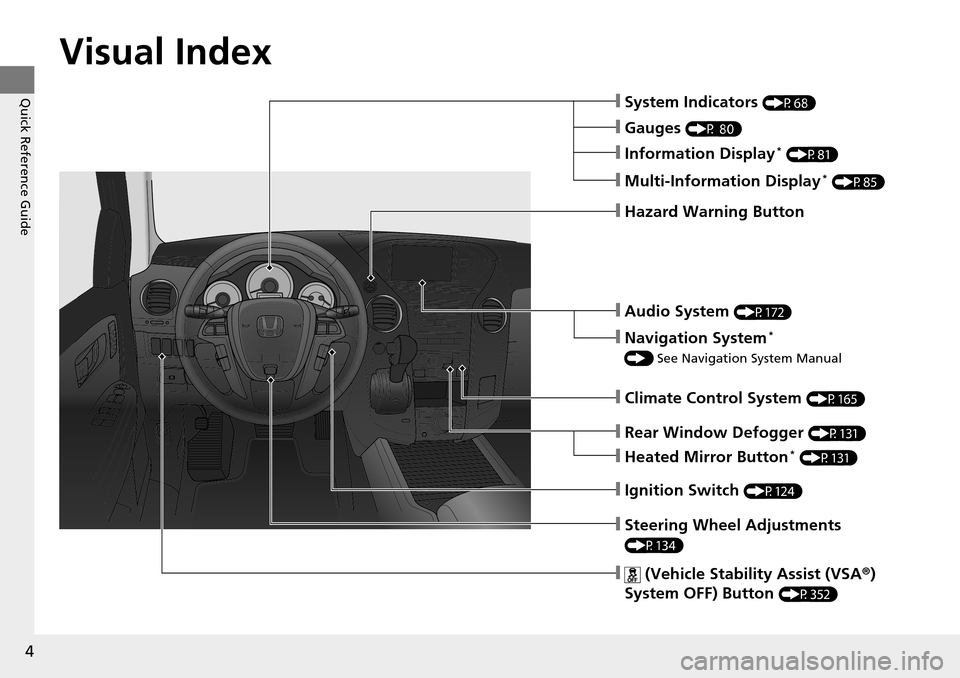
4
Quick Reference Guide
Quick Reference Guide
Visual Index
❙Steering Wheel Adjustments
(P134)
❙ (Vehicle Stability Assist (VSA®)
System OFF) Button
(P352)
❙Gauges (P 80)
❙Information Display* (P81)
❙System Indicators (P68)
❙Multi-Information Display* (P85)
❙Hazard Warning Button
❙Audio System (P172)
❙Navigation System*
() See Navigation System Manual
❙Climate Control System (P165)
❙Rear Window Defogger (P131)
❙Heated Mirror Button* (P131)
❙Ignition Switch (P124)
Page 10 of 488
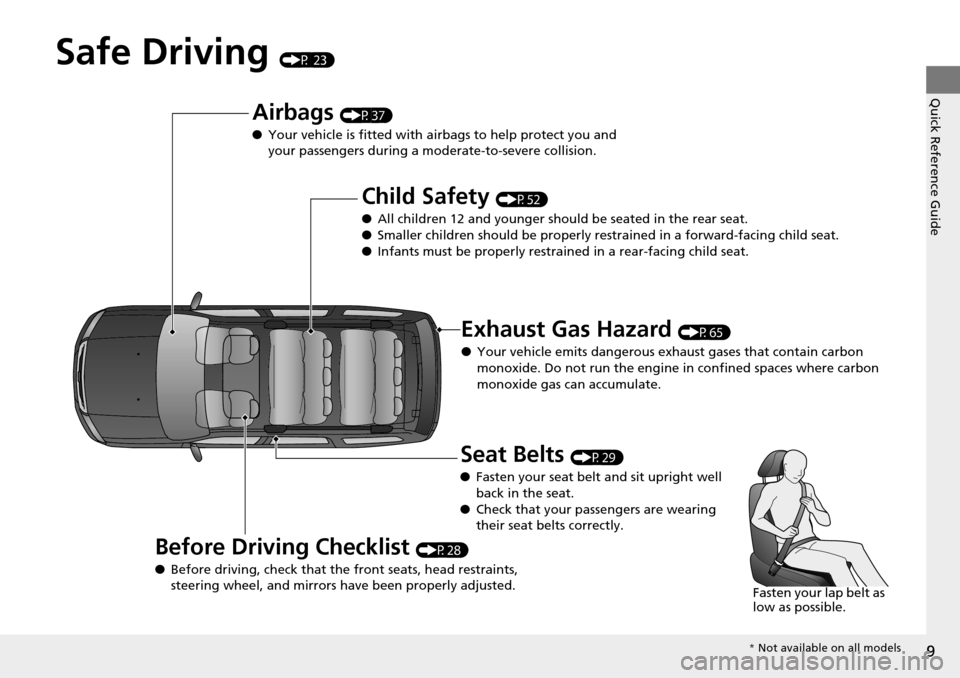
9
Quick Reference Guide
Safe Driving (P 23)
Airbags (P37)
● Your vehicle is fitted with ai rbags to help protect you and
your passengers during a moderate-to-severe collision.
Child Safety (P52)
● All children 12 and younger should be seated in the rear seat.
● Smaller children should be properly restra ined in a forward-facing child seat.
● Infants must be properly restraine d in a rear-facing child seat.
Exhaust Gas Hazard (P65)
● Your vehicle emits dangerous exhaust gases that contain carbon
monoxide. Do not run the engine in confined spaces where carbon
monoxide gas can accumulate.
Before Driving Checklist (P28)
● Before driving, check that the front seats, head restraints,
steering wheel, and mirrors have been properly adjusted.
Seat Belts (P29)
● Fasten your seat belt and sit upright well
back in the seat.
● Check that your passengers are wearing
their seat belts correctly.
Fasten your lap belt as
low as possible.
* Not available on all models
Page 13 of 488
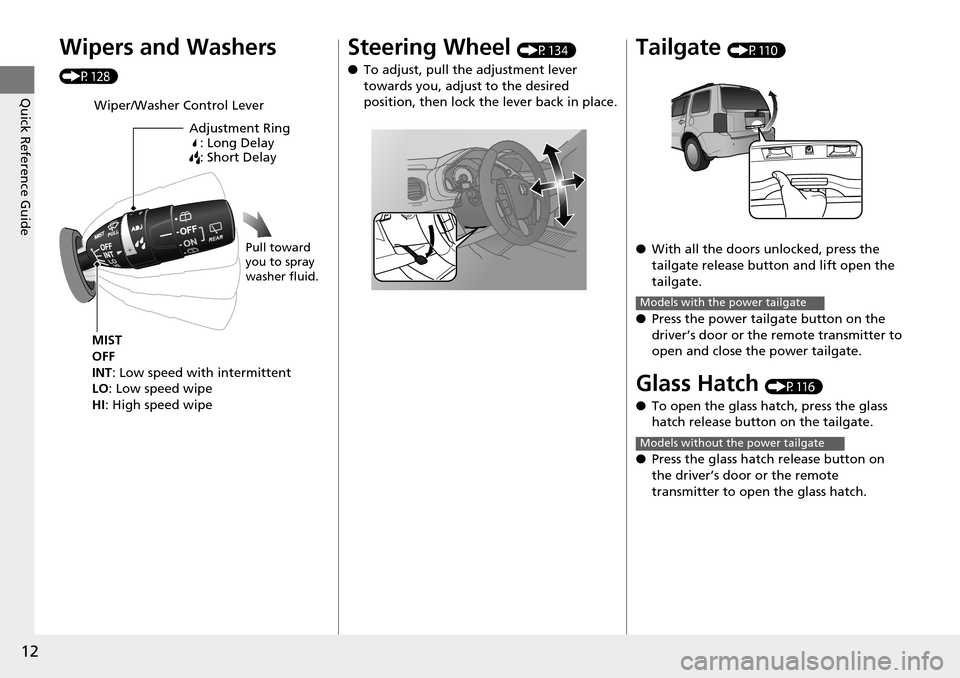
12
Quick Reference Guide
Wipers and Washers
(P128)
Wiper/Washer Control LeverAdjustment Ring: Long Delay
: Short Delay
MIST
OFF
INT : Low speed with intermittent
LO: Low speed wipe
HI : High speed wipe
Pull toward
you to spray
washer fluid.
Steering Wheel (P134)
● To adjust, pull the adjustment lever
towards you, adjust to the desired
position, then lock the lever back in place.Tailgate (P110)
● With all the doors unlocked, press the
tailgate release button and lift open the
tailgate.
● Press the power tailgate button on the
driver’s door or the remote transmitter to
open and close the power tailgate.
Glass Hatch (P116)
● To open the glass hatch, press the glass
hatch release button on the tailgate.
● Press the glass hatch release button on
the driver’s door or the remote
transmitter to open the glass hatch.
Models with the power tailgate
Models without the power tailgate
Page 21 of 488
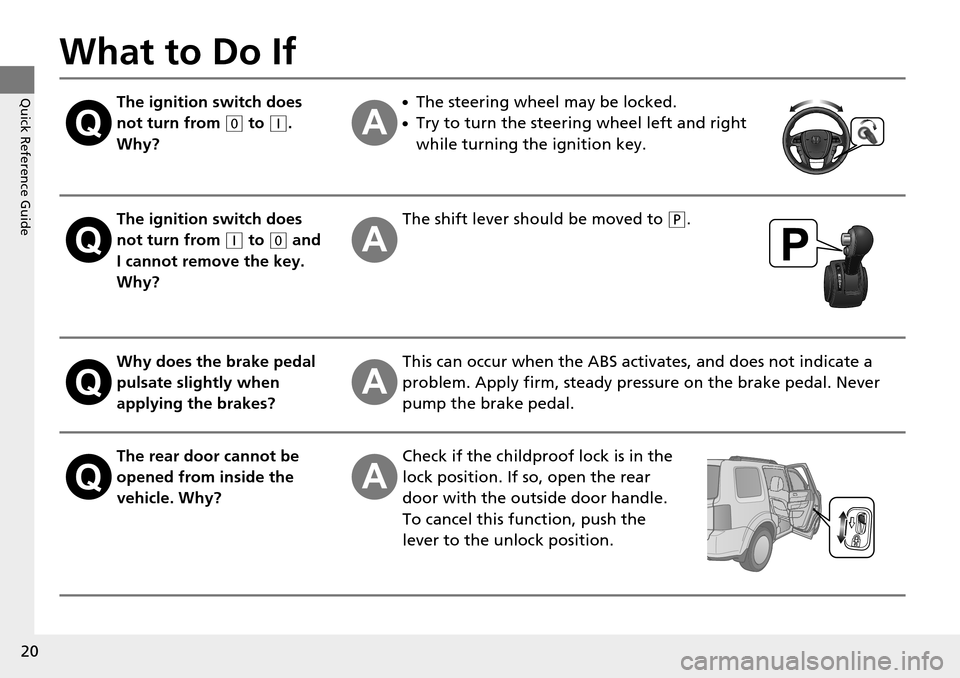
20
Quick Reference Guide
What to Do If
The ignition switch does
not turn from
(0 to (q.
Why?
●The steering wheel may be locked.
●Try to turn the steering wheel left and right
while turning the ignition key.
The ignition switch does
not turn from
(q to (0 and
I cannot remove the key.
Why?
The shift lever should be moved to (P.
Why does the brake pedal
pulsate slightly when
applying the brakes?This can occur when the ABS activates, and does not indicate a
problem. Apply firm, steady pressure on the brake pedal. Never
pump the brake pedal.
The rear door cannot be
opened from inside the
vehicle. Why?Check if the childproof lock is in the
lock position. If so, open the rear
door with the outside door handle.
To cancel this function, push the
lever to the unlock position.
Page 28 of 488
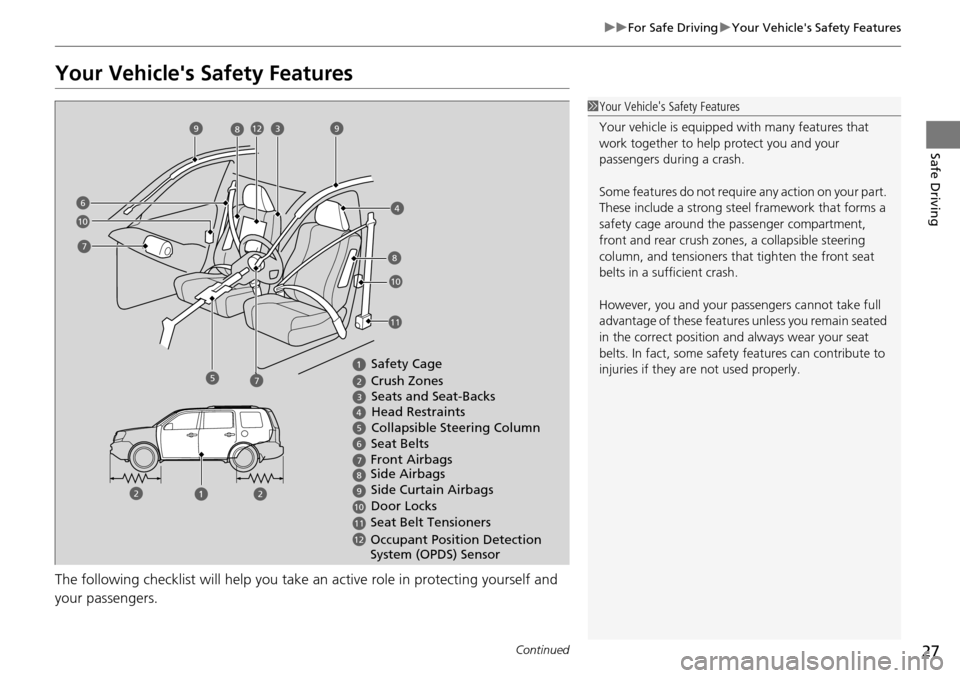
27
uuFor Safe Driving uYour Vehicle's Safety Features
Continued
Safe Driving
Your Vehicle's Safety Features
The following checklist will he lp you take an active role in protecting yourself and
your passengers.
1 Your Vehicle's Safety Features
Your vehicle is equipped wi th many features that
work together to help protect you and your
passengers during a crash.
Some features do not require any action on your part.
These include a strong steel framework that forms a
safety cage around the passenger compartment,
front and rear crush zone s, a collapsible steering
column, and tensioners that tighten the front seat
belts in a sufficient crash.
However, you and your passe ngers cannot take full
advantage of these features unless you remain seated
in the correct position and always wear your seat
belts. In fact, some safety features can contribute to
injuries if they are not used properly.
2
3
4
5
6
78
9
10
11
12
Safety Cage
Crush Zones Seats and Seat-BacksHead Restraints
Collapsible Steering Column
Seat Belts
Front Airbags
Side Airbags Side Curtain Airbags
Door Locks
Seat Belt Tensioners
Occupant Position Detection
System (OPDS) Sensor
2
10
9
7
8
3456
78
10
1112
2
9
Page 39 of 488
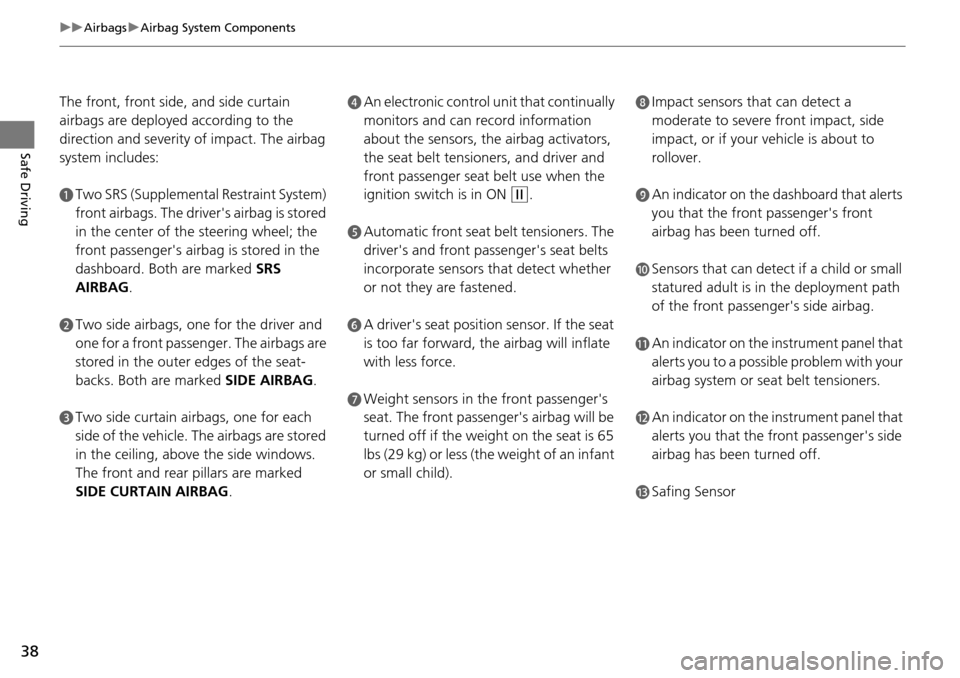
38
uuAirbags uAirbag System Components
Safe Driving
The front, front side, and side curtain
airbags are deployed according to the
direction and severity of impact. The airbag
system includes:
aTwo SRS (Supplemental Restraint System)
front airbags. The driver's airbag is stored
in the center of the steering wheel; the
front passenger's airbag is stored in the
dashboard. Both are marked SRS
AIRBAG.
bTwo side airbags, one for the driver and
one for a front passenger. The airbags are
stored in the outer edges of the seat-
backs. Both are marked SIDE AIRBAG .
cTwo side curtain airbags, one for each
side of the vehicle. The airbags are stored
in the ceiling, above the side windows.
The front and rear pillars are marked
SIDE CURTAIN AIRBAG.
dAn electronic control unit that continually
monitors and can record information
about the sensors, the airbag activators,
the seat belt tensioners, and driver and
front passenger seat belt use when the
ignition switch is in ON
(w.
eAutomatic front seat belt tensioners. The
driver's and front passenger's seat belts
incorporate sensors that detect whether
or not they are fastened.
fA driver's seat position sensor. If the seat
is too far forward, the airbag will inflate
with less force.
gWeight sensors in the front passenger's
seat. The front passenger's airbag will be
turned off if the weight on the seat is 65
lbs (29 kg) or less (the weight of an infant
or small child).
hImpact sensors that can detect a
moderate to severe front impact, side
impact, or if your vehicle is about to
rollover.
iAn indicator on the dashboard that alerts
you that the front passenger's front
airbag has been turned off.
jSensors that can detect if a child or small
statured adult is in the deployment path
of the front passenger's side airbag.
kAn indicator on the instrument panel that
alerts you to a possible problem with your
airbag system or seat belt tensioners.
lAn indicator on the instrument panel that
alerts you that the fr ont passenger's side
airbag has been turned off.
mSafing Sensor
Page 40 of 488

39
uuAirbags uAirbag System Components
Safe DrivingAirbags can pose serious hazards. To do their job, airbags must inflate with
tremendous force. So, while airbags help sa ve lives, they can cause burns, bruises,
and other minor injuries, and sometimes even fatal ones if occupants are not
wearing their seat belts properly and sitting correctly.
What you should do: Always wear your seat belt properly, and sit upright and as
far back from the steering wheel as possibl e while allowing full control of the
vehicle. A front passenger should move thei r seat as far back from the dashboard as
possible.
Remember, however, that no safety system ca n prevent all injuries or deaths that
can occur in a severe crash, even when s eat belts are properly worn and the airbags
deploy.
Do not place hard or sharp objects between yourself and a front airbag.
Carrying hard or sharp objects on your lap, or driving with a pipe or other sharp
object in your mouth, can result in in juries if your front airbag inflates.
Do not attach or place object s on the front airbag covers. Objects on the
covers marked SRS AIRBAG could interfere with the proper operation of the airbags
or be propelled inside the vehicle an d hurt someone if the airbags inflate.
■Important Facts About Your Airbags1Important Facts About Your Airbags
Do not attempt to deactivate your airbags. Together,
airbags and seat belts pr ovide the best protection.
When driving, keep hands and arms out of the
deployment path of the fro nt airbag by holding each
side of the steering wheel. Do not cross an arm over
the airbag cover.
Page 41 of 488
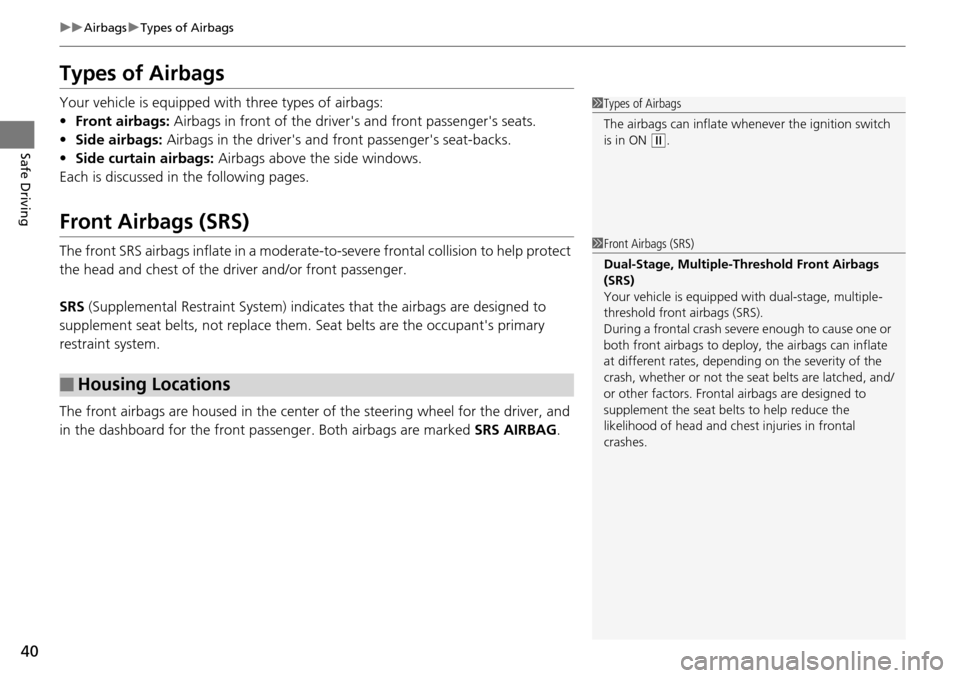
40
uuAirbags uTypes of Airbags
Safe Driving
Types of Airbags
Your vehicle is equipped with three types of airbags:
• Front airbags: Airbags in front of the driver 's and front passenger's seats.
• Side airbags: Airbags in the driver's and front passenger's seat-backs.
• Side curtain airbags: Airbags above the side windows.
Each is discussed in the following pages.
Front Airbags (SRS)
The front SRS airbags inflate in a moderate-to -severe frontal collision to help protect
the head and chest of the driver and/or front passenger.
SRS (Supplemental Restraint System) indica tes that the airbags are designed to
supplement seat belts, not replace them. Seat belts are the occupant's primary
restraint system.
The front airbags are housed in the center of the steering wheel for the driver, and
in the dashboard for the front pass enger. Both airbags are marked SRS AIRBAG.
■Housing Locations
1Types of Airbags
The airbags can inflate whenever the ignition switch
is in ON
(w.
1 Front Airbags (SRS)
Dual-Stage, Multiple-Threshold Front Airbags
(SRS)
Your vehicle is equipped wi th dual-stage, multiple-
threshold front airbags (SRS).
During a frontal crash severe enough to cause one or
both front airbags to deploy, the airbags can inflate
at different rates, dependi ng on the severity of the
crash, whether or not the se at belts are latched, and/
or other factors. Frontal airbags are designed to
supplement the seat belts to help reduce the
likelihood of head and chest injuries in frontal
crashes.
Page 98 of 488
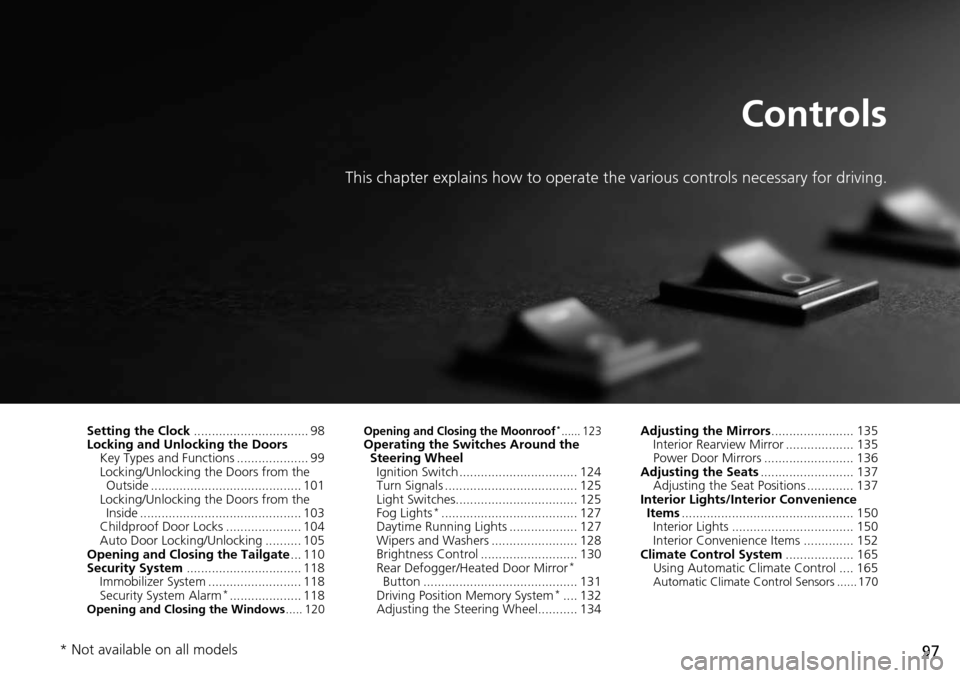
97
Controls
This chapter explains how to operate the various controls necessary for driving.
Setting the Clock................................ 98
Locking and Unlocking the Doors
Key Types and Functions .................... 99
Locking/Unlocking the Doors from the Outside .......................................... 101
Locking/Unlocking the Doors from the Inside ............................................. 103
Childproof Door Locks ..................... 104
Auto Door Locking/Unlocking .......... 105
Opening and Closing the Tailgate ... 110
Security System ................................ 118
Immobilizer System .......................... 118
Security System Alarm
*.................... 118Opening and Closing the Windows ..... 120
Opening and Closing the Moonroof*...... 123Operating the Switches Around the
Steering Wheel Ignition Switch ................................. 124
Turn Signals ..................................... 125
Light Switches.................................. 125
Fog Lights
*...................................... 127
Daytime Running Lights ................... 127
Wipers and Washers ........................ 128
Brightness Control ........................... 130
Rear Defogger/Heat ed Door Mirror
*
Button ........................................... 131
Driving Position Memory System
*.... 132
Adjusting the Steering Wheel........... 134 Adjusting the Mirrors
....................... 135
Interior Rearview Mirror ................... 135
Power Door Mirrors ......................... 136
Adjusting the Seats .......................... 137
Adjusting the Seat Positions ............. 137
Interior Lights/Interior Convenience Items ................................................ 150
Interior Lights .................................. 150
Interior Convenience Items .............. 152
Climate Control System ................... 165
Using Automatic Climate Control .... 165Automatic Climate Control Sensors ...... 170
* Not available on all models